Diaspora: Lessons from Trinidad and Guyana
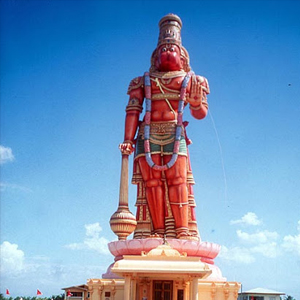
The Indians of these Caribbean nations are fully assimilated—and yet, remarkably, have maintained their religious heritage despite generations of disconnect from the land their ancestors left behind.
A tall overpowering statue of Hanuman stands boldly over the Caribbean Sea on the island of Trinidad. While large statues of Hindu deities are a common sight throughout India, one might ask: why on a small island thousands of miles away?
[Left] The towering 85-feet tall Hanuman murti on the grounds of the Dattatreya Yoga Center and Mandir in Carapichaima, Trinidad.
As it happens, a large percentage of the population of the Caribbean nations of Trinidad and Guyana trace their ancestry to the Indian subcontinent. However, their sociopolitical connections with their roots, after several generations, are now feeble to nonexistent. Most of them consider themselves “Trinidadian” or “Guyanese.”
And yet, aspects of their distant Indian heritage, especially in the realm of religion, remain deeply embedded in their lifestyle, even if they don’t identify themselves overtly as Indian.
The global Indian diaspora is among the largest, most diverse, and established immigrant groups worldwide. However, the specific identity and its manifestations vary by geography depending on the community’s migration history, ethnolinguistic makeup, and societal impact. There is even an Encyclopedia of the Indian Diaspora compiled by Professor Brij V. Lal, which reflects on the diversity of the Indian diaspora worldwide on several levels. While distinct Indian culture is evident in places that have witnessed a more recent influx from the subcontinent, it is much more subtle and interwoven in areas where the first “pioneers” arrived beginning in the mid-1800s, more than 200 years ago.
I remember Surge Singh, an Indo-Fijian acquaintance, who I met in 2011 while traveling in Australia. I recently messaged him to ask about his Indian roots. Not surprisingly, he responded with, “I do not know. My family history is not clear.” He then added, “I always thought our style of curries was similar to South Indian cuisine,” to which I replied, “Historical evidence shows that most of the migrants in your area hailed from Northern India.” “How did they land on a far-flung Pacific island four or five generations ago?” he asked. My questions had sparked his curiosity to uncover the footsteps of his ancestors.
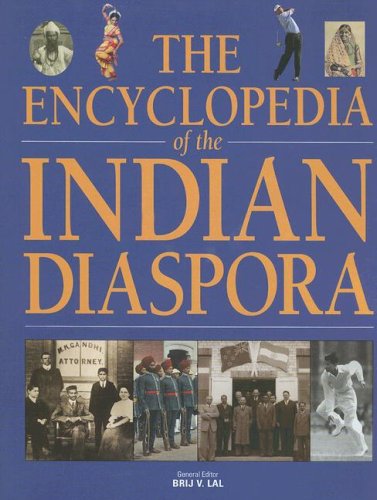 My own curiosity about the Indian diaspora was spiked when I enrolled in an “Indian Ocean History” seminar as a senior at the University of South California (USC). The professor, Ketaki Pant, USC’s only South Asian historian at the time, is a young and innovative scholar with a unique approach to analyzing history. Rather than studying history from the limited perspective of a nation’s political boundaries, Professor Pant used the Indian Ocean as the nodal point for exploring the interlinked histories of migration, colonialism, and cultural belonging.
My own curiosity about the Indian diaspora was spiked when I enrolled in an “Indian Ocean History” seminar as a senior at the University of South California (USC). The professor, Ketaki Pant, USC’s only South Asian historian at the time, is a young and innovative scholar with a unique approach to analyzing history. Rather than studying history from the limited perspective of a nation’s political boundaries, Professor Pant used the Indian Ocean as the nodal point for exploring the interlinked histories of migration, colonialism, and cultural belonging.
[Right] Encyclopedia of the Indian Diaspora compiled by Professor Brij V. Lal.
Professor Pant introduced me to Gaiutra Bahadur’s book, Coolie Woman, which provided a very nuanced understanding of my views on the Indian diaspora. The story revolves around Bahadur’s journey to rediscover her roots as a fourth-generation Indo-Guyanese. Although she felt culturally connected with India, she was not “Indian enough” to fit in with New York’s East Indian community. Thus, she traveled to India to retrace her great-grandmother’s footsteps and discover the realities that had propelled her grandmother to leave India. As she understood more of her ancestral history, Bahadur also understood her own identity as an Indo-Guyanese in New York.
Similar to Bahadur, I have often asked myself, “Where do I belong?” While I am more culturally Indian, my actual relationship with India is defined from the lens of someone who was born in California to first generation upper-middle-class professionals.
The counterpoint provided by Indian families whose ancestors left India well over a century ago helped me gain insight into my own place as a first-generation Indian-American.
The first morning we arrived in Trinidad, my father and I visited the Indian Caribbean Museum of Trinidad & Tobago in the Waterloo District of Port of Spain. Although it only comprises one room, the museum contains a vast collection of artifacts and archives that illustrate the early history of Indians in the Caribbean.
Indians are the largest ethnic group in Trinidad, comprising 37 percent of the total population of almost 1.4 million. The abolition of slavery in 1834 fueled the demand for labor throughout the colonial world. Between 1838 and 1917, the British transported half a million Indian indentured laborers to the Caribbean to work on sugar cane plantations. Trinidad and Guyana were the most common Caribbean destinations, while thousands of others went to Mauritius and Fiji.
Unlike slavery, which is lifelong bondage, indentured laborers held temporary contracts to work abroad for at least five years. In return for labor, their basic needs, including accommodation, food and pay, were taken care of. At the end of their contract, the laborers were granted a return passage to India or, if they chose to remain, ten acres of the land they had worked on.
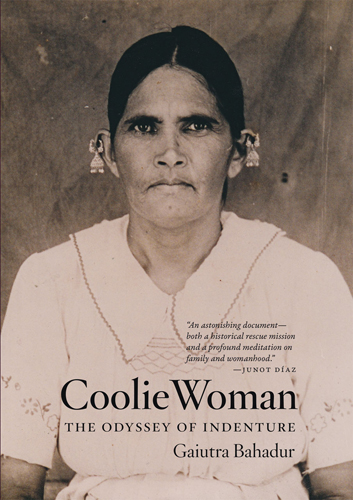 The demand for overseas labor in the 1800s coincided with the deterioration of the Indian economy. As India was flooded with British manufactured products, issues like landlessness, unemployment and famine became rampant. In the face of overwhelming economic hardship in the northern agricultural regions of Awadh which is modern day Uttar Pradesh, and Bhojpur in Bihar, many local laborers signed on to sail to the Caribbean as indentured laborers.
The demand for overseas labor in the 1800s coincided with the deterioration of the Indian economy. As India was flooded with British manufactured products, issues like landlessness, unemployment and famine became rampant. In the face of overwhelming economic hardship in the northern agricultural regions of Awadh which is modern day Uttar Pradesh, and Bhojpur in Bihar, many local laborers signed on to sail to the Caribbean as indentured laborers.
[Left] Coolie Woman, by Gaiutra Bahadur is about Bahadur’s journey to rediscover her roots as a fourth-generation Indo-Guyanese.
In addition to those migrating for economic reasons, some, mostly women, sought to escape oppressive societal conditions. In Coolie Women, Bahadur’s great grandmother was a Brahmin widow from the village of Ghurahupur, Bihar. “According to tradition, [she was] supposed to negate [herself] in mourning forever, could not remarry, inherit property and [hence], was subject to hunger and poverty [without] sons to support [her].”
Religion in rural India was defined by conservative, hierarchal societal norms. Thus, abandoning India was “liberating” for the laborers who had no means of upward mobility. Given the oppressive traditions faced by many of the laborers who saw indentured labor as an opportunity for overcoming barriers, the interpretation of Hinduism that evolved was inevitably more liberal than the caste system that they left behind.
The diaspora’s continued adherence to Hinduism is evident through the abundance of temples constructed within the past few decades. A Huffington Post article, “The Hindus of the Caribbean: An Appreciation,”
explains how Indo-Caribbean Hindus became more pious due to trauma and abuse they experienced during the voyage from the subcontinent and on the plantations. Proselytizing efforts by British missionaries helped further cement their Hindu identity, as they resisted conversion to an unfamiliar religion.
Waterloo is home to two of Trinidad’s most famous Hindu temples: The Temple in the Sea and the Sri Dattatreya Yoga Centre and Temple. The Temple in the Sea was originally constructed in 1947 by Shivdass Sadhu, an Indian laborer. As the name suggests, this small temple stands on a stone base a few feet from shore. The large murti (statue) of Shiva at the start of the pathway made me feel just like a pilgrim whose satanic thoughts were being destroyed before they transcended into the overpowering aura of the shrine in the sea. As we walked in circular motion around the large murtis of Hanuman, Ganesh and Saraswati, I felt as if I was receiving my blessings before returning to the world of desire and suffering on the other side of the bridge.
The Dravidian-style Sri Dattatreya Yoga Centre and Temple was constructed in 1986 by Sri Ganapathy Sachchidananda Swamiji. An ornate 85-foot-high Hanuman statue, the biggest in the western hemisphere, majestically watches over the complex. As I stood under Hanuman’s towering presence, a majestic figure with his club in hand, I felt as if Hanuman was protecting me from menacing forces of evil, just as he did for Lord Rama in Lanka.
The St. James District of Port of Spain is closely linked with the Indian diaspora’s early history. It was developed in the late 19th century when Indian indentured laborers established homes and businesses near the sugar estates where they had labored. The area remains a bustling commercial hub, home to appliance stores, grocery markets, meat shops and cafes run by Indo-Trinidadians. Several of the streets are named after major Indian cities such as Calcutta Street, and so on for Delhi, Madras, Patna, Cawnpore (modern-day Kanpur), and Bombay.
By the 19th century, most of the diaspora had decided to permanently reside in the Caribbean. According to The Encyclopedia of the Indian Diaspora, many had developed a sense of place in the region, as they cultivated close networks with other laborers and, in some cases, started families. By the 1880s, Indians were allowed to purchase property which further integrated them into mainstream society. This, in turn, spurred the residential and commercial growth of Port of Spain’s districts such as St. James.
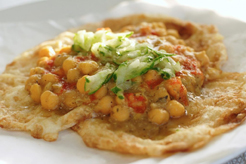 My main memory of St. James is the abundance of roti shops. The origin of roti in Trinidad dates back to when indentured laborers made roti on handmade tava (griddles). A staple dish of Trinidad, Guyana and Suriname, the Caribbean style roti is a fried flat bread similar to a large Indian poori, generally served with curry and stew.
My main memory of St. James is the abundance of roti shops. The origin of roti in Trinidad dates back to when indentured laborers made roti on handmade tava (griddles). A staple dish of Trinidad, Guyana and Suriname, the Caribbean style roti is a fried flat bread similar to a large Indian poori, generally served with curry and stew.
[Right] Roti Doubles, the iconic street food of the Caribbeans, has its origins in its Indian population.
Indian influenced dishes such as roti, curry and pilau, have put Caribbean cuisine on the map. Julie Sahni writes in her LA Times article, “A Passage to Trinidad,” “[the Indian-style cuisine ] evolved by borrowing elements from the islands’ environment and assumed a character of its own.” Today, these foods are such an integral part of Trinidadian cuisine that their Indian roots have almost completely been forgotten. Sahni recalls how a saleswoman at a curry factory asked her, “Do they also have curry powder in India?” While this question appears ignorant, it reflects the interconnectedness and assimilation of all ethnic groups as defining characteristics of Caribbean society.
Although most former laborers became integrated into Caribbean society, some still dreamed of returning to India. In 1955, some 250 ex-laborers fled political upheaval in Guyana and returned to India. Bahadur states that “repatriates saw the dream, but not the blunder of returning to India.” Once they arrived, many were lost in Kolkata where the Bengali language was completely indecipherable from their mother tongues of Awadhi and Bhojpuri. Those who were able to return to their villages were ostracized for “losing their caste” by traversing the oceans. As social outcasts, many were confined to the slums of Kolkata where they were subjects of looting and thievery, and lost all the savings with which they had optimistically returned to their Indian homeland.
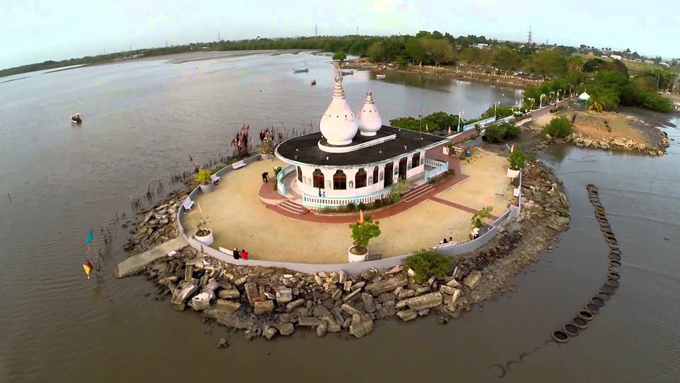
[Top] The Temple in the Sea at Waterloo, Trinidad, is another monument of the Hindu heritage of the Indians of the country.
Today, many descendants of Indian indentured laborers have achieved worldwide fame, putting the larger diaspora on the map. These include V.S. Naipaul, the Trinidadian writer; Rohan Kanhai and Shivnarine Chanderpaul, the Guyanese cricketers; and Vijay Singh, the Fijian golfer. Whenever I hear these names, I feel a sense of pride because I see them as representative of all ethnic Indians regardless of their nationality. Ultimately, we all share a common land of origin, and the variety of diasporic cultures adds richness to the greater Indian identity that unites us.
The beauty of the U.S.A., like the Caribbean, is that American citizens comprise of a multitude of ethnicities united under an American identity. Non- desi Americans are increasingly learning about enjoying and adopting Indian cultural elements. For instance, yoga and chess are so interwoven into the American lifestyle that most do not associate them with originating in India. I am grateful to belong to a nation where I can enjoy and share my native culture alongside learning from other traditions around me. That, I believe, is the key to the unity and acceptance that is deeply rooted in Trinidad and must be enshrined in America.
Nikhil Misra-Bhambri is a freelance journalist living in Los Angeles, California. He graduated in history from University of Southern California (USC) and writes about relationships between cultures, cuisine, music and history.
Enjoyed reading Khabar magazine? Subscribe to Khabar and get a full digital copy of this Indian-American community magazine.
blog comments powered by Disqus










